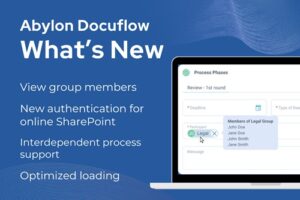
Effective Master Data Management with the Abylon Rapid Platform

Who needs Master Data Management?
If You already know, that you need Master Data management, feel free to skip this part and jump right here! This quick overview helps you to understand the business needs why a company might need a master data management tool and to provide some real-life business use-cases.
Imagine a Business Intelligence (BI)-system! – Ok, but how? – You might ask, and really, what is the substance in business terms of a BI-system (BI as Business Intelligence). I won’t be going into that in academic terms, but one way to look at BI-systems is that:
„A Business Intelligence system is a solution package, which gathers data from one or several source systems in order to create reports from it.”
Please also let me hereby express my apologies to true BI-developers. They probably have a much better definition, but for now, and for the sake of simplicity, let’s stick with this definition.
Use case I. - Basic categorization
You want to categorize your vendors in a new way, to make a new report but in your ERP system (a source system for the BI in this case) there is no field or option currently for that kind of categorization, and it would take a lot of resources to add that field. This custom development is not on the development road map, but you still have to create a report using this categorization. Maybe you have to build reports on this ground, maybe you have to build/develop even more operational stuff.
Use case II. - Tax report change
Imagine that for some reason the international tax-environment changes (or will likely to change very soon), and the reports you’re taking care of need a rapid readjustment for planning, but operationally you are not able to change the source-system’s tax-categorization data.
Use case III. - Integration of new ERP system
Your company is implementing a new ERP-system, but you have one or multiple legacy systems, which have dimension attributes (for example: categorizations of vendors) in the legacy system(s) and in the current bi-system, which are already in place, but the new system is based on a different logic, thus this kind of categorization will be replaced, but you don’t want to change all your reporting structures straight up since the new system will be implemented in the long-run, country-by-country.
Use case IV. - Affiliates with different accounting systems
Downsides of the "old-school" approach to Master Data Management
If you’re coming from business (as I do) your first idea to solve any of the above use cases is to gather all the data in Excel-files. Then, eventually put them in a some SharePoint folder and then share the Excel files across multiple users throughout the globe. Right? This is a legit approach right?
Yes it is, if you’re absolutely comfortable with the „Demons of the Shadow IT” haunting you utill the end of your practice at that company… I know what I’m talking about. I’ve built the shadow IT for years… Here are dome of the problems with this approach:
- User rights management
- Multiple Access
- Logging and history tracking
- Simple validations
How to validate the values? Okay, Excel’s data validation is a viable an option here. We use it too. The problem is, that it can be easily overwritten, so it’s not a bullet-proof solution.
- Complex validations
What if there are more complex validation rules that have to be applied? Validation based on some sort of business logic.
Imagine that you can only add data in a column which is between the min and max values of another table’s column’s data. Like you have to set monitor sizes, and there is a possible minimum and maximum value stored somewhere based on the available stock. How do you handle this?
Business Intelligence with adequate Master Data Management
Let’s start with usability! Just like with any other IT solution, usability, and therefore the User Interface is a key factor. What’s the best UI in this case? If you are guessing I hope you got it right! It’s the one and only MS Excel. I’m not joking. Excel is still the most universal (and most popular) tool for every controller or even office worker dealing with data.
Of course it has it weaknesses, so we gave our usual Excel UI some superpowers! We connected it to a database through our Excel add-in available directly in Excel itself. So what are the benefits of that? Let’s see a few:
- Universal usability
Since we are connected to a standard SQL database, this connection can be used for any other standard purpose like being a data source for your queries, reports, or BI-system built somewhere else.
- Common ground for enterprises
- Excel-based configuration
- Business users can take care of the data in Excel
- Logging and history tracking
- Key reference
- Complex validations
Simple validation rules are not enough and you need to have custom validations based on business rules? Again, no problem! Any rule that can be described logically (and is a straightforward logic), can be developed in SQL and placed in a custom validation script, so that your data can only have values which are allowed!
Modern enterprise-grade MDM in just a couple of weeks
I’m not a marketing person. I don’t like big words. I used to be one of those people who are ultimately the end-users of these solutions. Based on that experience I can say that once your company starts doing Master Data Management with the Abylon Rapid Platform is won’t just be a small step, but a huge jump toward efficiency. You will have a automated, flexible, easily customizable solution that radically reduces all the manual work related to any MDM-related task.
Moreover, because our solution is built on top of Excel – a familiar and widely used tool for users involved in these tasks – the implementation won’t take more that a couple of weeks!
If you want to improve your Master Data Management and what you just read sounds interesting give us 30 minutes of your time to present you our solution and show you that all the above is not just talk!

Author of the post:
Zsolt Kreisz - Financial Controller in the past, now BI Developer at Abylon Consulting. Linkedin Profile
Found this post interesting?
Subscribe to our newsletter to receive updates of similar post and news!





